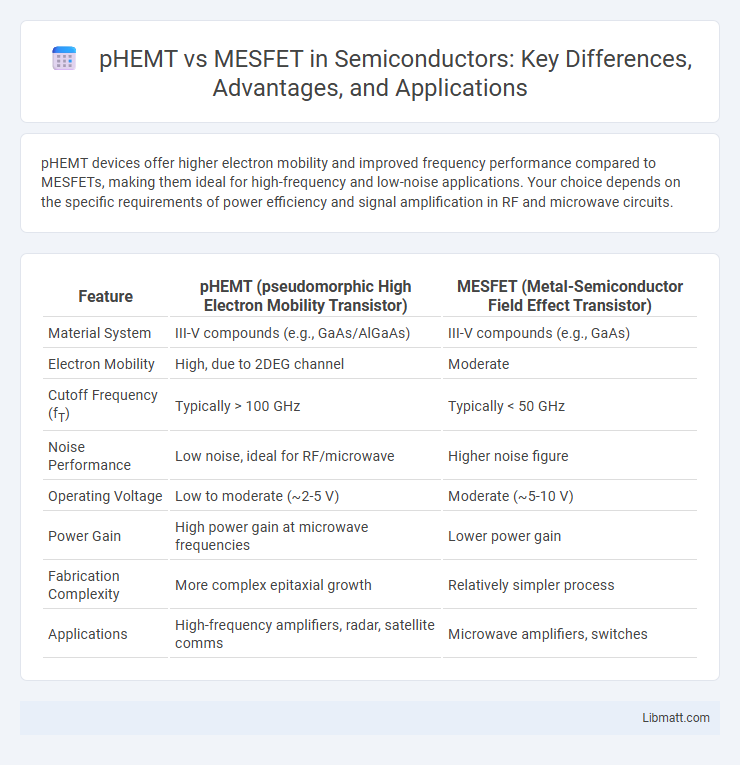pHEMT devices offer higher electron mobility and improved frequency performance compared to MESFETs, making them ideal for high-frequency and low-noise applications. Your choice depends on the specific requirements of power efficiency and signal amplification in RF and microwave circuits.
Table of Comparison
| Feature | pHEMT (pseudomorphic High Electron Mobility Transistor) | MESFET (Metal-Semiconductor Field Effect Transistor) |
|---|---|---|
| Material System | III-V compounds (e.g., GaAs/AlGaAs) | III-V compounds (e.g., GaAs) |
| Electron Mobility | High, due to 2DEG channel | Moderate |
| Cutoff Frequency (fT) | Typically > 100 GHz | Typically < 50 GHz |
| Noise Performance | Low noise, ideal for RF/microwave | Higher noise figure |
| Operating Voltage | Low to moderate (~2-5 V) | Moderate (~5-10 V) |
| Power Gain | High power gain at microwave frequencies | Lower power gain |
| Fabrication Complexity | More complex epitaxial growth | Relatively simpler process |
| Applications | High-frequency amplifiers, radar, satellite comms | Microwave amplifiers, switches |
Introduction to pHEMT and MESFET Technologies
pHEMT (pseudomorphic High Electron Mobility Transistor) and MESFET (Metal-Semiconductor Field-Effect Transistor) are advanced semiconductor devices used in high-frequency and microwave applications. pHEMT technology leverages a heterojunction to create high electron mobility and improved performance at microwave frequencies, whereas MESFETs utilize a Schottky metal-semiconductor junction for switchable conduction. Your choice between pHEMT and MESFET will impact device speed, noise figure, and overall efficiency in RF circuits.
Basic Structure and Working Principles
pHEMTs (pseudomorphic High Electron Mobility Transistors) feature a heterojunction between semiconductor materials of different bandgaps, creating a two-dimensional electron gas (2DEG) channel with high electron mobility, which enhances speed and frequency response. MESFETs (Metal-Semiconductor Field-Effect Transistors) utilize a Schottky metal-semiconductor junction as the gate, controlling the current flow through a bulk semiconductor channel with relatively lower electron mobility than pHEMTs. The pHEMT's heterojunction design enables superior electron confinement and higher transconductance, while MESFETs rely on a simpler metal-semiconductor interface, resulting in distinct performance and frequency characteristics.
Key Material Differences
pHEMT devices utilize a heterojunction structure, typically combining materials like GaAs and AlGaAs, enabling a two-dimensional electron gas (2DEG) with high electron mobility and low noise performance. MESFETs are constructed from a single semiconductor layer, often GaAs, relying on Schottky gate contacts, which results in higher noise and lower electron mobility compared to pHEMTs. The heterostructure design in pHEMTs offers superior electron confinement and velocity, making them more efficient for high-frequency applications than MESFETs.
Performance Characteristics Comparison
pHEMTs offer higher electron mobility and superior frequency response compared to MESFETs, making them ideal for high-frequency applications such as RF amplifiers and microwave circuits. MESFETs typically have greater robustness and simpler fabrication processes but exhibit lower gain and noise performance under the same operating conditions. Your choice between pHEMT and MESFET depends on whether enhanced speed and low noise or device durability and cost-efficiency are the priority in your application.
Frequency Response and Bandwidth
pHEMT devices typically offer superior frequency response and wider bandwidth compared to MESFETs due to their higher electron mobility and lower noise characteristics. The heterojunction structure in pHEMTs enables faster carrier transport, resulting in higher cutoff frequencies (fT) and maximum oscillation frequencies (fmax). Your high-frequency applications benefit from pHEMTs' enhanced gain and efficiency, making them preferable for microwave and millimeter-wave circuits.
Noise Performance and Linearity
pHEMT devices offer superior noise performance compared to MESFETs, making them ideal for low-noise amplifier applications in high-frequency communication systems. MESFETs generally exhibit better linearity, which benefits power amplifier designs where signal distortion must be minimized. Your choice depends on whether low noise or linearity is paramount for your specific RF circuit requirements.
Power Efficiency and Output Capability
pHEMTs (pseudomorphic High Electron Mobility Transistors) demonstrate superior power efficiency compared to MESFETs (Metal-Semiconductor Field-Effect Transistors), primarily due to their higher electron mobility and lower noise figure. These characteristics enable pHEMTs to deliver greater output power and improved linearity, especially at microwave and millimeter-wave frequencies. MESFETs, while effective, generally exhibit lower output capability and higher power dissipation under comparable operating conditions.
Applications in RF and Microwave Circuits
pHEMTs excel in high-frequency RF and microwave circuits due to their superior electron mobility and low noise figure, making them ideal for low-noise amplifiers, oscillators, and mixers in satellite communications and radar systems. MESFETs, while offering good high-frequency performance and robustness, are commonly used in power amplifiers and switches within microwave communication and radar transceivers. The choice between pHEMT and MESFET depends on the required trade-off between noise performance and power handling capabilities in specific RF applications.
Reliability and Manufacturing Considerations
pHEMTs generally offer higher reliability due to superior electron mobility and lower noise, making them preferred for high-frequency and low-noise applications. MESFETs benefit from simpler manufacturing processes using standard GaAs technology, which can reduce production costs and improve yield compared to the more complex heterojunction structures in pHEMTs. Your choice between pHEMT and MESFET should balance the need for device performance with manufacturing capabilities and long-term reliability requirements.
Choosing Between pHEMT and MESFET for Your Design
Selecting between pHEMT and MESFET hinges on application requirements such as frequency range, noise performance, and linearity. pHEMTs excel in high-frequency, low-noise applications due to their heterojunction structure and higher electron mobility, making them ideal for RF amplifiers and microwave circuits. MESFETs offer robustness and cost-effectiveness in moderate-frequency applications, often preferred for power amplifiers and switches where linearity and reliability are critical.
pHEMT vs MESFET Infographic

 libmatt.com
libmatt.com